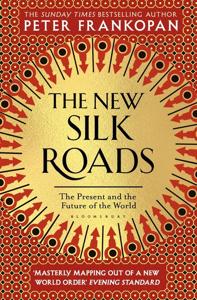
Want to learn the ideas in The New Silk Roads better than ever? Read the world’s #1 book summary of The New Silk Roads by Peter Frankopan here.
Read a brief 1-Page Summary or watch video summaries curated by our expert team. Note: this book guide is not affiliated with or endorsed by the publisher or author, and we always encourage you to purchase and read the full book.
Video Summaries of The New Silk Roads
We’ve scoured the Internet for the very best videos on The New Silk Roads, from high-quality videos summaries to interviews or commentary by Peter Frankopan.
1-Page Summary of The New Silk Roads
Overview
Across the world, we’re seeing a shift from Western dominance to Eastern power. This is because of China’s investment in other countries and the failure of Western politics.
Historians are now aware that the world of today wasn’t just shaped by Western countries but also countries along the Silk Roads. These ancient trading routes ran through China and Central Asia, and were crucial to the shaping of our modern society.
But that was a long time ago. What about now? How is the East influencing international affairs today?
Join us as we learn about the economic shift of power from Western nations to Eastern ones. We will examine how these changes will affect people around the world and what it means for political leaders in those countries. Furthermore, we’ll look at some of America’s and Europe’s most influential brands and institutions, which might be challenged by this change.
Read further to learn about China’s new friends in Europe, how the ancient Silk Roads are making a comeback, and what impact Western politics is having on China’s rise.
Big Idea #1: As a result of the rapid economic growth in Asia, many people are becoming wealthy. They’re buying Western businesses and properties and traveling to the West more frequently.
In the past, wealthy Englishmen would travel to places like Rome and Venice. They would buy expensive objects from these places as part of a tradition known as the Grand Tour. This was because England had become a powerful country with lots of money thanks to its military and commercial success.
Until recently, trophy hunting was mostly done by wealthy Westerners. But now that the economic power is shifting to the East, people from China and Russia are doing it more often.
Significantly, the world’s new elite want to get their hands on Western trophies. For instance, when Russia wanted to host a major sporting event such as the World Cup or Winter Olympics, they did so. The same goes for some of the most prestigious art galleries in London and Paris; they moved overseas because it made sense economically for them to do so.
The trophy hunting doesn’t stop there. World-famous stores like Harrods and Hamleys are owned by people from Dubai, Russia or China.
The rise of Eastern economies will have other effects on Westerners.
For example, in the last 30 years, there has been a five-fold increase in Chinese tourists spending abroad. They spend $500 million to $250 billion annually and twice as much as Americans do now. This will have an impact on the tourism industry by changing everything from airlines and online booking agents to hotel rooms and drinks offered at hotels. The rise of this type of travel is only going to get bigger because China’s tourism is still in its infancy with only 20% of people having passports currently.
Big Idea #2: The West is attempting to isolate itself from the rest of the world, while Asia is engaging in partnerships and trade.
In the Western world, people are turning to nationalism and distancing themselves from other Western countries. For example, Donald Trump’s 2016 election slogan was “America First,” which means that America should isolate itself from the rest of the world. Another example is Brexit: Britain’s decision in 2016 to distance itself from its European neighbors with a vote to leave the European Union (EU).
While Western nations have been isolating themselves, the Eastern world has been working together. They’re consolidating their ties and finding mutually beneficial solutions to shared challenges.
Central Asia is one of the areas that has been most affected by the Silk Road. There are many countries in Central Asia, and they’ve recently started working together on things like building bridges over rivers that connect them. For example, Uzbekistan and Turkmenistan have built a bridge over the Amu Darya river, which connects their two countries. This will enable trade between them to increase significantly.





